› Forums › Variable Stars › Nova in Cas
- This topic has 39 replies, 12 voices, and was last updated 3 years, 11 months ago by
 Jeremy Shears.
Jeremy Shears.
-
AuthorPosts
-
30 July 2020 at 9:16 am #574686
 Jeremy ShearsParticipant
Jeremy ShearsParticipantAccording to ATel 13904, the 12.9mag (unfiltered with V zero-point) optical transient TCP J00114297+6611190 was identified on 2020-07-27.9302 UT by S. & K. Korotkiy and spectroscopically confirmed as a Fe II type classical nova on 2020-07-29.025 with the 2.5m Sternberg Astronomical Institute telescope by the team of Kirill Sokolovsky.
Nova Cas 2020 has coordinates (J2000.0): R.A. 00 11 42.96 Decl. +66 11 20.8
Observations and spectroscopy urgently required. An AAVSO chart and sequence are available.
30 July 2020 at 1:49 pm #582943 Jeremy ShearsParticipant
Jeremy ShearsParticipantDavid Swan has an image on his Members page of the nova taken last night.
I’ve seen CCD and Vis observations from the early hours of this morning (30th) placing it between mag 13.5 and 13.9.
30 July 2020 at 2:16 pm #582944 David SwanParticipant
David SwanParticipantFor some reason the uploaded pic has come out a bit dark. It is, I suspect, something to do with the fact that I saved the image first as a png in Maxim. The file was still a bit large though, so I opened that in Photoshop and did a web compression. I’ll have a look this eve at putting something slightly better up. I also need to test whether the boxcar or the bayer pane setting for flat calibration works best with this particular calibration frame set.
Anyway, I was keen to have a look at the nova! I am actually planning to revisit low res spectroscopy with the StarAnalyser in a much more rigorous way: dark and flat calibration and then instrument response correction using a standard star at a similar altitude.
30 July 2020 at 3:26 pm #582945 Robin LeadbeaterParticipant
Robin LeadbeaterParticipantHi David,
I would not bother attempting flat correction of slitless spectra. Normal flat correction techniques do not work because each point is a mix of spectral and spatial information. (The technique used on professional setups is complex and involves generating effectively a “flat cube” for each wavelength at each point in the field.) My advice would be to take a conventional flat beforehand to check for any obvious dust donuts etc and place your target and reference star zero orders as near as possible on the same pixel avoiding any dust spots so any gross flat effects eg vignetting etc cancel.
Cheers
Robin
30 July 2020 at 6:52 pm #582946 David SwanParticipant
David SwanParticipantThanks Robin, I’ll do as you advise. Here’s a not so egregiously black-clipped image. I’ll have a look at the pixel brightness values to see if I can get anything reliable from the green pane.
31 July 2020 at 7:23 am #582950 Nick JamesParticipant
Nick JamesParticipanthttps://britastro.org/node/23563. I get 12.6 unfiltered last night using Gaia DR2 G mags.
31 July 2020 at 11:45 am #582952 David BoydParticipant
David BoydParticipantHere is a spectrum of Nova Cas 2020 recorded with a LISA spectrograph on a C11 SCT and calibrated in absolute flux using a concurrently measured magnitude of V = 13.395. Using PlotSpectra, the integrated absolute flux of the H-alpha and H-beta lines are 3.53E-12 and 2.52E-13 erg/cm2/sec respectively. These results are consistent with the values 3.54E-12 and 2.54E-13 reported in ATel 13905. The apparent FWHM of the H-alpha line is 508 km/s and there is evidence of weak P Cyg absorption on the blue side of H-alpha extending to -800 km/s relative to the peak of emission. There are also emission lines of Fe II 5018, Fe II 5169, [O I] 5577 and an unidentified emission line at ~6160 A.
David
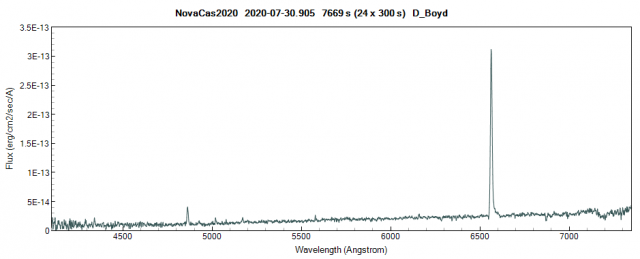
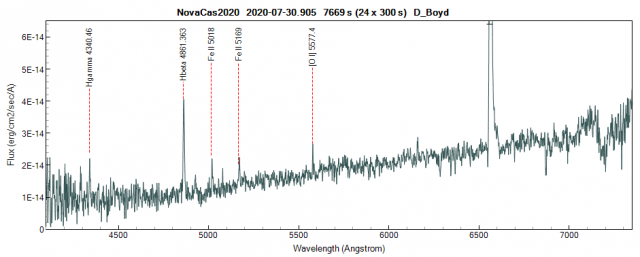 31 July 2020 at 3:04 pm #582953
31 July 2020 at 3:04 pm #582953 Gary PoynerParticipant
Gary PoynerParticipantMy first opportunity to see Nova Cas ’20. In a grotty sky using the AAVSO sequence, visual 13.4 on Jly 30.938.
The first Nova (detected) in Cassiopeia since V723 Cas (Nova 1995), which is still visible around 16.5 mag.
Gary
31 July 2020 at 4:21 pm #582954 Robin LeadbeaterParticipant
Robin LeadbeaterParticipantHere is the region from H beta and redwards covering the “Fe curtain” region at R~1950 with the LHIRES and 600l/mm grating
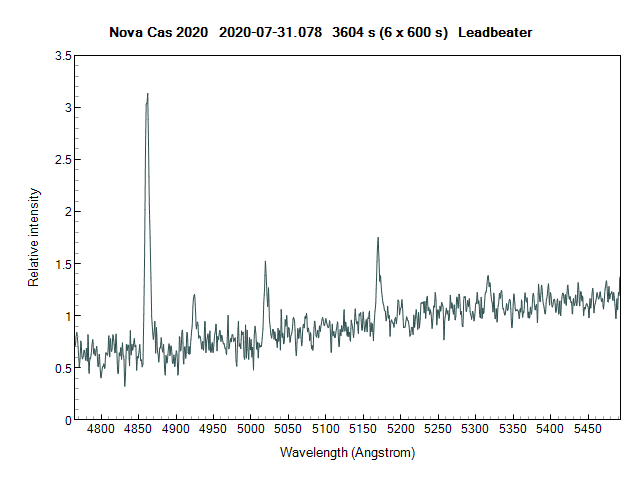
The H beta FWHM is ~360km/s after correcting for the spectrograph resolution but there may be some higher velocities redwards in the line profiles
Cheers
Robin
1 August 2020 at 9:44 am #582958 Lars LindhardParticipant
Lars LindhardParticipantI saw the nova last night and estimated the mag. to 12.7.
1 August 2020 at 3:25 pm #582961 Gary PoynerParticipant
Gary PoynerParticipantYes Lars, it looks as if it’s getting a little brighter. I had 13.0 visual in a cloud break just after dark last night (31st)
Gary
1 August 2020 at 9:37 pm #582964 David SwanParticipant
David SwanParticipantExcellent, thanks Stewart. I’m waiting on clear skies to acquire a low res spectrum of the object. At this brightness, it should be doable with my scope.
3 August 2020 at 5:01 pm #582963 Stewart John BeanParticipant
Stewart John BeanParticipantI find the following from this morning using T5 (250 mm) in New Mexico at JD 2459062.902. I used AstroimageJ
With V filter, nova was 12.9 using 11.2 ,14.3, and 12.6, reference stars in AAVSO chart
With R filter, nova was 12.4 using 12.6 in AAVSO chart
With B filter, nova was 13.3 using 12.6 and 13.7 in AAVSO chart
Seems quite bright through the red filter. Stewart
5 August 2020 at 4:41 pm #582971 Stewart John BeanParticipant
Stewart John BeanParticipantI make it 11.8 mag through V filter this morning, Aug 5th at 01 :43. (T18, Nerpio, Spain.)
I make it 11.1 mag through the R filter.
For both measurements the reference star was 11.2 on the AAVSO chart. I’ll try to get these uploaded via Muniwin once I get the hang of it.
7 August 2020 at 11:33 am #582982 David SwanParticipant
David SwanParticipantI took images last night through a V filter and measured a calibrated stack in Maxim (AAVSO X25582AO)
N Cas 2020 measured 11.548 CCD-V
REF 112 set 11.186
CHK 126 measured 12.599
13 August 2020 at 9:11 am #582999 John CoffinParticipant
John CoffinParticipantThis is a spectrum from the early hours of 12th August. It looks very different from those of the 30th and 31st July in this thread. The H alpha line is much reduced and there appears to be a P Cygni profile, presumably due to expansion of the nova. I haven’t tried to identify the other broad absorption features. I would be interested in other people’s comments on what this spectrum tells us about the evolution of the nova. I see from the database that others have also noticed the changing profile.
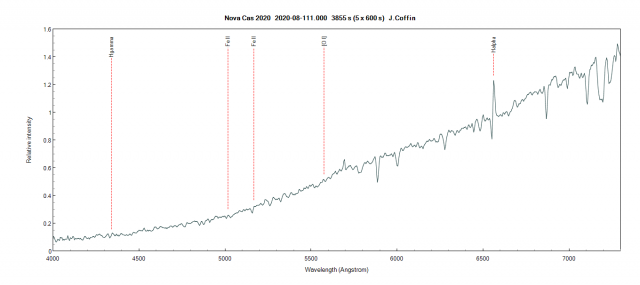 13 August 2020 at 11:52 am #583000
13 August 2020 at 11:52 am #583000 Robin LeadbeaterParticipant
Robin LeadbeaterParticipantHi John,
There was an excellent detailed commentary on the evolution of nova spectra by Prof Steve Shore during the Nova Del 2013 ARAS campaign here
http://www.astrosurf.com/aras/novae/Nova2013Del.html
He has also issued an ATel on the current nova based on amateur spectra
http://www.astronomerstelegram.org/?read=13939
Cheers
Robin
17 August 2020 at 10:34 pm #583019 John CoffinParticipant
John CoffinParticipantThanks Robin, very useful.
John
18 August 2020 at 1:00 pm #583020 Gary PoynerParticipant
Gary PoynerParticipantObservations from last night and this morning suggest Nova Cas is rebrightening after a very short four day decline.
At this stage the light curve resembles several other Nova I have observed over the years – V1493 Aql (N Aql 1999#1), V2274 Cyg (N Cyg 2001) and the Fe II Nova V2362 Cyg (N Cyg 2006), although the time scales of fading and rebrightening are different.
The light curve below is from visual observations and unfiltered CCD from SLOOH. Thank goodness for remote scopes – the night sky here in Brum has been very cloudy of late, although I did have a forty minute gap last night (17th).
Gary
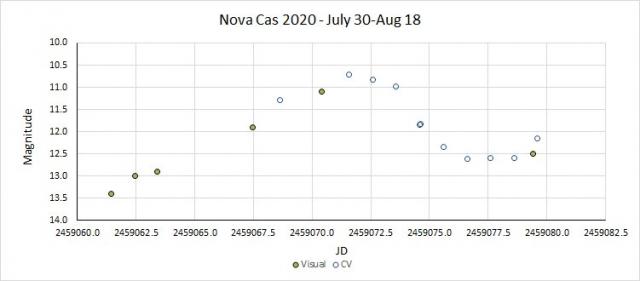 19 August 2020 at 3:29 pm #583022
19 August 2020 at 3:29 pm #583022 John CoffinParticipant
John CoffinParticipantThe H alpha line has become very prominent again and the P Cygni profile has disappeared. There appear to be emission lines for Fe II, He I and [O I]. The spectrum was recorded around midnight on 18th/19th August with an Alpy 600 and the resolution is ~ 550.
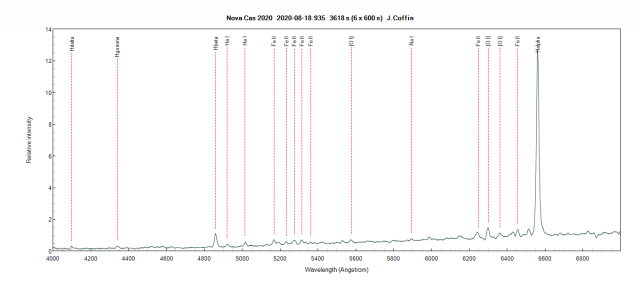
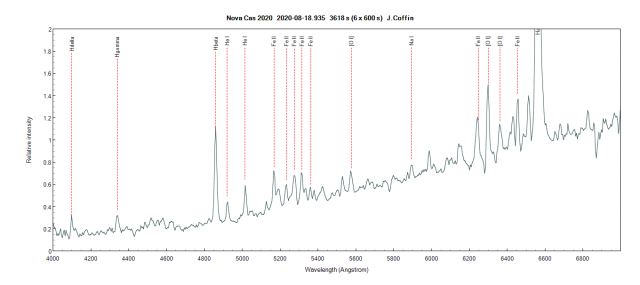
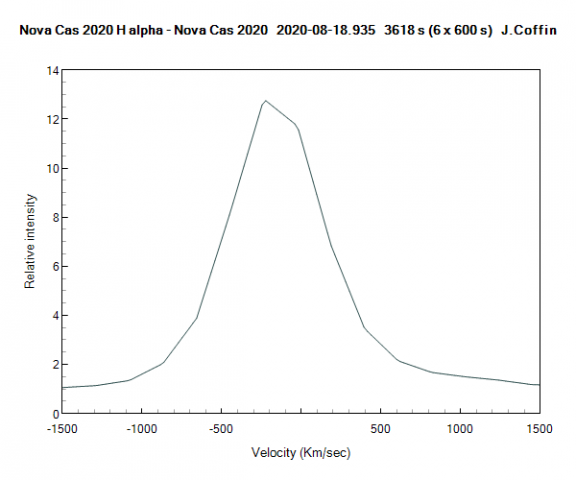
-
AuthorPosts
- You must be logged in to reply to this topic.
